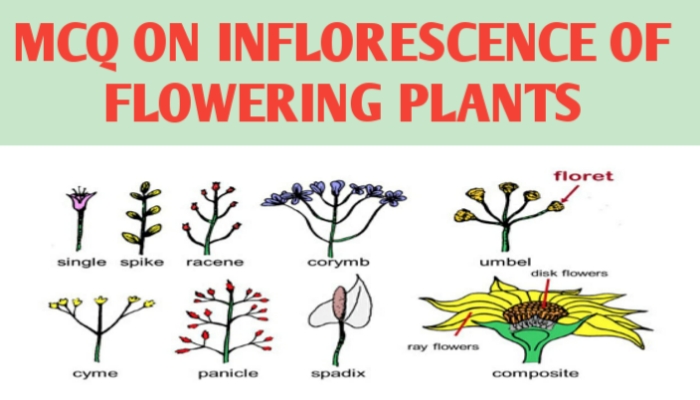MCQ ON INFLORESCENCE OF FLOWERING PLANTS class 11 for NEET | INFLORESCENCE of flowering plant class 11 MCQ | INFLORESCENCE OF FLOWERING with Answer | Check the below NCERT MCQ question for class 11 Biology chapter 5 based on INFLORESCENCE OF FLOWERING PLANTS with Answers.

MCQ ON INFLORESCENCE OF FLOWERING PLANTS
MCQ on INFLORESCENCE of Flowering Plants class 11 Biology with answers were prepared based on the latest pattern. We have provided class 11 Biology MCQs questions on INFLORESCENCE OF FLOWERING PLANTS with Answers to help students understand the concept very well.
MCQ on INFLORESCENCE OF FLOWERING PLANTS is useful for NEET / CSIR / UGC / CBSE / ICSE / AIIMS / EXAM / AFMC EXAM / JAC exam/ STATE LEVEL MEDICAL EXAM 2022-23
Introduction:-
The flowers are borne singly or in clusters. A flowering shoot or an axis bearing a cluster of flowers is called inflorescence. The main axis of an inflorescence is called peduncle.When the flowers occur singly , they are called solitary and the stalk of a solitary flower is also called peduncle.
MCQ ON INFLORESCENCE OF FLOWERING PLANTS class 11 for NEET
1. A flowering shoot or an axis bearing a clusters of flowers is called
(a) inflorescence
(b) venation
(c) phyllodes
(d) phyloclade
Ans (a) inflorescence
2. The main axis of an inflorescence is called
(a) peduncle
(b) leaf blade
(c) petiole
(d) all the above
Ans. (a) peduncle
3. Racemose, cymose are types of
(a) basipetal order
(b) acropetal order
(c) inflorescence
(d) axillary buds
Ans. (c) inflorescence
4. Peduncle is elongated but the flowers have no stalks and arranged in acropetal succession
(a) spike
(b) catkin
(c) umbel
(d) all the above
Ans.(a) spike
5. A pendulous spike inflorescence consisting of small unisexual flowers.
(a) catkin
(b) spadix
(c) umbel
(d) all the above
Ans.(a) catkin
ALSO READ:-
● YOU CAN WATCH BIOLOGY SIR Youtube channel
6. It is modified raceme in which the flower have stalks of nearly equal length and they seem to arise from the same point at the apex of a short deduncle.
(a) umbel
(b) corymb
(c) spadix
(d) all the above
Ans.(a) umbel
7. All the plants belonging to a family asteraceae have inflorescence
(a) catkin
(b) spadix
(c) umbel
(d) capitulum
Ans.(d) capitulum
8. In ficus carica , ficus religiosa , special types of flowers are found
(a) catkin
(b) spadix
(c) hypanthodium
(d) all the above
Ans.(c) hypanthodium
9. The types of inflorescence found in euphorbia pulcherrima
(a) hypanthodium
(b) cyathium
(c) verticillaster
(d) all the above
Ans. (b) cyathium
10. In an inflorescence where flowers are borne laterally in an acropetal succession , the position of the youngest floral bud shall be
(a) proximal
(b) distal
(c) intercalary
(d) pulvinus
Ans. (b) distal
11. Pattern of arrangement of leaves on stem is known as
(a) phyllode
(b) phyllotaxy
(c) phylloclade
(d) heterophylly
Ans.(b) phyllotaxy
12. The type of inflorescence the main axis terminates in a flower , hence is limited in growth.The flowers are borne in a basipetal order.
(a) racemose
(b) cymose
(c) capitulum
(d) all the above
Ans.(b) cymose
13. The type of inflorescence the main axis continues to grow , the flowers are borne laterally in an acropetal succession
(a) cymose
(b) racemose
(c) pitchers
(d) bith a and b
Ans.(b) racemose
14. Verticillaster is a special type of cymose inflorescence found in many plants belonging to family
(a) asteraceae
(b) leguminousae
(c) labiatae
(d) all the above
Ans.(c) labiatae
15. It is a modified raceme with relatively short peduncle in which the lower flower have much elongated pedicels than upper ones so that all flowers come to the same level.
(a) corymb
(b) umbel
(c) capitulum
(d) spadix
Ans. (a) corymb
16. When the flowers occur singly , they are called ?
(a) solitary
(b) inflorescence
(c) both a and b
(d) terminal buds
Ans.(a) solitary
17. Mustard , radish and linaria are
(a) spike
(b) typical raceme
(c) umbel
(d) catkin
Ans.(b) typical raceme
18. In Maize , banana , colocasia type of inflorescence found
(a) catkin
(b) spadix
(c) corymb
(d) umbel
And.(b) spadix
19. In coriander type of inflorescence found is ?
(a) compound corymb
(b) compound umbel
(c) compound spadix
(d) cladodes
Ans. (b) compound umbel
20. It is a special type of cymose inflorescence which is much condensed and looks like a single bisexual flower.
(a) hypanthodium
(b) cyathium
(c) verticillaster
(d) all the above
Ans.(b) cyathium







Leave a Comment